|
 Nederlands /
Dutch Nederlands /
Dutch
Subpage flies:
Tachinidae
Blow-flies
(Calliphoridae) House
flies (Muscidae) Soldierflies
(Stratiomyidae) Root-Maggot
Flies (Anthomyiidae)
Small
flies Gnats
Hoverflies, Syrphidae
|
Hoverflies,
Flower
Flies
(Syrphidae) One of their characteristics is their bee, wasp or bumblebee
mimicry, whereas they are completely defenceless. Flower flies cannot
sting. They have same the
bright colours, and sometimes the dense hair covering of bumblebees.
Hovering is a speciality, but they are also fast and very manoeuvrable.
The difference with other flies is the spurious vein. This vein neither
ends nor connects with other wing veins. The
spurious vein just ends for the edge of the wings.
Cell 2 is closed. The closed cell 4 is longer or as long as one third of
the length of the wing.
The arista is on the side of the third antennal segment. Not on the top.
On the thorax are no stiff hairs like other flies.
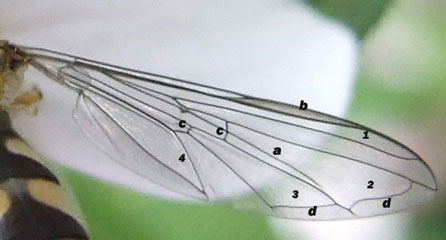 .. ..

Wing of a Meliscaeva
auricollis.
Antenna of a volucella zonaria.
Wing:
1, 2, 3, 4: closed cell
a: vena spuria or a false vein
b: stigma
c: cross vein
d: outer cross vein |
Antenna:
1: third antennal segment (you can't see the other two on this photo)
2: arista
|
Females
have smaller eyes which are placed farther apart. The eyes of the male
meet at the top of the head. Of course there are exceptions. Than you have
to look at the underside of the abdomen, males have curbed asymetricla
genitalia. The abdomen of the female is more pointed with inconspicuous
genitalia.
Many species feed mainly on nectar and pollen. The larvae (maggots) eat a
wide range of foods.
Exceptions
No vena spuria: Eristalinus sepulchralis and Psilota anthracina.
Arista op the top: Callicera and Ceriana
Stiff hairs: Ferdinandea. Less: Volucella, Cheilosia, Brachyopa and
Chamaesyrphus.
(Information from: Zweefvliegtabel van Aat
Barendregt)
|
On this page are the hoverflies which look like bees
and bumblebees. Some hoverflies on this page look also like wasps. (such as
species of the genus Epistrophe) The dark species are also on this page.
Other hoverflies you can find on hoverflies
2 (wasp
mimics)
Eristalis
These hoverflies are Honeybee mimics or (Eristalis intricaria) sometimes
bumblebee mimics. The larvae are rat-tailed maggots.
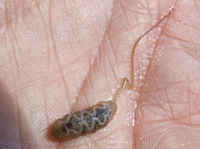 . .
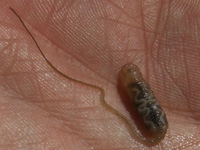 The larvae of Erisalis are
rat-tailed
maggots and feed on rotting organic material in stagnant water. The
tail is a breathing tube.
The larvae of Erisalis are
rat-tailed
maggots and feed on rotting organic material in stagnant water. The
tail is a breathing tube.
When fully grown, the larva creeps out to pupate.

 Another larvae out of the pond. Photo 3-4-2010.
Another larvae out of the pond. Photo 3-4-2010. |
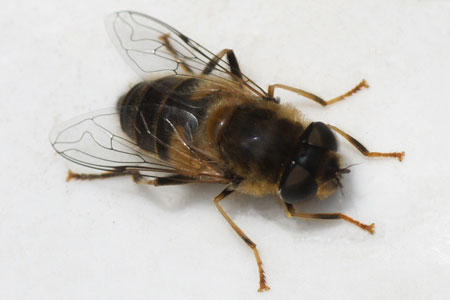 .. ..
 . .
 Tapered Drone Fly (Eristalis pertinax). Genus:
Eristalis. Family hoverflies (Syrphidae).
Tapered Drone Fly (Eristalis pertinax). Genus:
Eristalis. Family hoverflies (Syrphidae).
The Eristalis
pertinax is almost similar to the Eristalis tenax. But it don't has
the two vertical stripes on the eyes. And the lower part of a leg (tars) is yellow. The abdomen of
males is conical.
Length 11-15 mm.
January - December. Eristalis feed on nectar and pollen.
Palearctic. But it has been introduced into North
America and is widely established. German: Gemeine
Keilfleckschwebfliege.
French: Eristale opiniâtre.
|
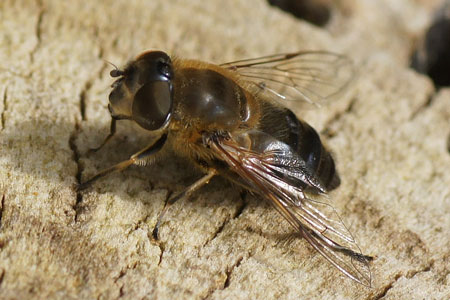 .. ..
 Glass-winged Drone Fly (Eristalis similis, synonym
Eristalis pratorum). Genus Eristalis. Family hoverflies (Syrphidae).
Glass-winged Drone Fly (Eristalis similis, synonym
Eristalis pratorum). Genus Eristalis. Family hoverflies (Syrphidae).
Eristalis similis looks like the Eristalis
pertinax and the Eristalis tenax.
But it has dark tarses and no vertical stripes on the eyes. The pterostigma is elongated and lightly
coloured in females. The abdomen of females is conical.
In the Netherlands the numbers are quite variable. In the area where I live, they are not common.
Length 13-16 mm.
March-September. Palearctic. |
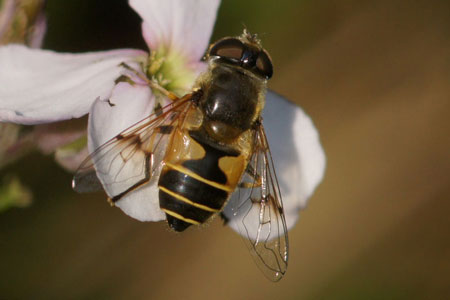 .. ..
 . .
 Stripe-winged Drone Fly (Eristalis horticola, synonym
Eristalis lineata). Genus: Eristalis. Family hoverflies (Syrphidae).
Stripe-winged Drone Fly (Eristalis horticola, synonym
Eristalis lineata). Genus: Eristalis. Family hoverflies (Syrphidae).
It is very similar to the Eristalis
interrupta but it has no clear wings.
The yellow rings on the abdomen, the yellow
spots and the dark band on the wings are characteristic.
Length 10-14 mm.
April-October.
It is be found especially near forests. Palearctic. Photos 28-8-2010, 20-4-2011.
German: Garten-Keilfleckschwebfliege.
|
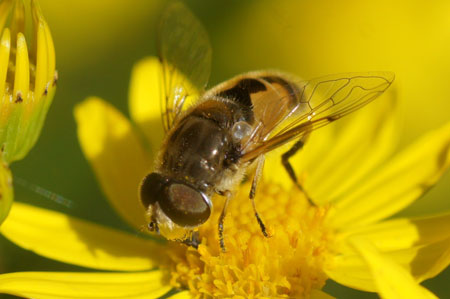 .. ..
 . .
 . .
 . .
 Eurasian Drone Fly (Eristalis arbustorum). Genus: Eristalis.
Family hoverflies (Syrphidae).
Eurasian Drone Fly (Eristalis arbustorum). Genus: Eristalis.
Family hoverflies (Syrphidae).
It is very similar to the Eristalis abusiva.
The face is white hairy. Sometimes there is a small black middle stripe on
the face. The Eristalis arbustorum has a hairy arista. The Eristalis abusiva has
an almost bare arista. A quarter of the shin of the Eristalis arbustorum
is deep black. A fifth of the shin of the Eristalis abusiva is black.
The eyes of the Eristalis arbustorum are touching each other's for some distance.
Between the eyes of the male Eristalis abusiva is a small distance.
Length 9-11mm. March - october. Palearctic.
Photos 10-8-2012. |
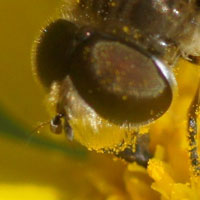 .
. 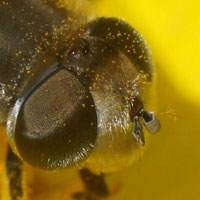 |
Eristalis arbustorum. Genus:
Eristalis. Family hoverflies (Syrphidae).
Details.
Photo left: Male. The eyes are touching each other for some distance. You
can see the hairy arista.
Photo right: Female. Also a hairy arista. It's difficult to get the hairy
arista on a photo.
I have no photos of a Eristalis abusiva.
|
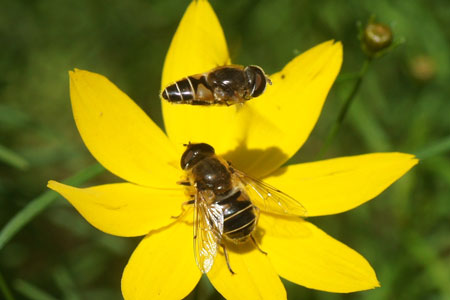 .. ..
 . .
 . .
 Stripe-faced Drone Fly (Eristalis nemorum, synonym Eristalis
interrupta). Genus: Eristalis. Family hoverflies (Syrphidae).
Stripe-faced Drone Fly (Eristalis nemorum, synonym Eristalis
interrupta). Genus: Eristalis. Family hoverflies (Syrphidae).
The male Eristalis interrupta often
hangs above the female.
The Eristalis interrupta has a bare black median line on the face.
It has a very small pterostigma in the wing. It is square or even broader
than long. The wings are clear. The female has not always the yellow
spots. The Eristalis interrupta and the Eristalis arbustorum
are very similar.
Sometimes the male is wrong and it hangs for a very short time above a
wrong species. Sometimes several males hang above one female. Length: 10-12 mm.
April-October. Holarctisc. Photos 14-8-2012, 16-8-2012. |
Epistrophe
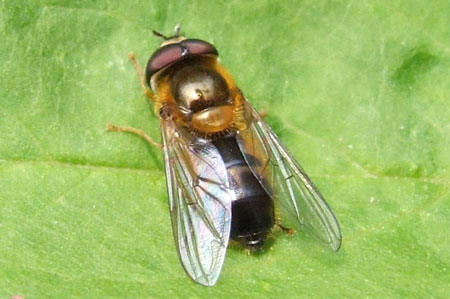 .. ..
 . .
 . .
 Spring Smoothtail (Epistrophe eligans). Genus: Epistrophe.
Family hoverflies (Syrphidae).
Spring Smoothtail (Epistrophe eligans). Genus: Epistrophe.
Family hoverflies (Syrphidae).
It's a springfly..
The first yellow band (sometimes separately) is
broader than the yellow band (also interrupted) Sometimes there is also
third band. A copper colored thorax with a beautiful gloss.
As you can see on the photos, there is a
difference in bands.
They occur in forest edges and shrubs.
Length: 9-11 mm. April-June.
 front.
German: Zweiband-Wiesenschwebfliege.
front.
German: Zweiband-Wiesenschwebfliege. |
 .. ..
 Female.
Female.  . .
 Male. Black-mouthed Smoothtail (Epistrophe
melanostoma) Genus: Epistrophe. Family hoverflies (Syrphidae).
Male. Black-mouthed Smoothtail (Epistrophe
melanostoma) Genus: Epistrophe. Family hoverflies (Syrphidae).
Similar to the in The Netherlands rare Epistrophe flava. Length: 10 - 12 mm.
April - June.
The larvae feed on aphids.
Photos 1-5-2010, 14-5-2010. |
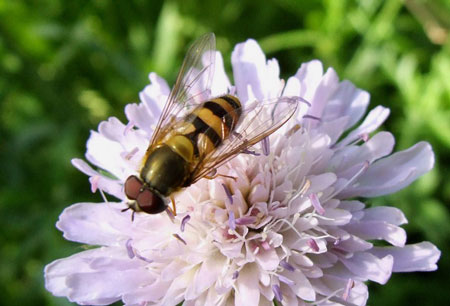 .. ..
 . .
 Male.
Male. 
 Female. Black-horned Smoothtail (Epistrophe
grossulariae). Genus:
Epistrophe. Family hoverflies (Syrphidae).
Female. Black-horned Smoothtail (Epistrophe
grossulariae). Genus:
Epistrophe. Family hoverflies (Syrphidae).
The only species in the northern Netherlands with black antennae. The forehead just above the antennae is black.
The thighs are dark at the beginning.
The thorax is dull. Try comparing with that of the E. eligans.
Length: 10 to 13 mm.
May to September.
The larvae feed on aphids.
Europe, North America. |
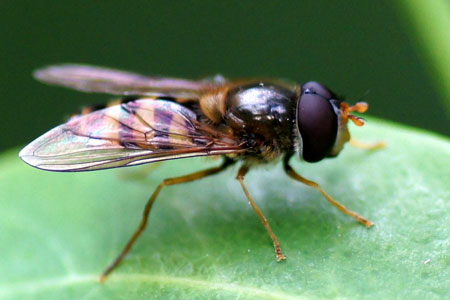 .. ..
 Male.
Male.  . .
 Female. Dark-backed Smoothtail (Epistrophe nitidicollis). Genus:
Epistrophe. Family hoverflies (Syrphidae).
Female. Dark-backed Smoothtail (Epistrophe nitidicollis). Genus:
Epistrophe. Family hoverflies (Syrphidae).
A hoverfly with yellow antennae and a very shiny
thorax. On the scutellum are black hairs (a difference with the other
similar species).
Length 9-12 mm.
April-July. One generation. Holarctic. Photo's 22-6-2013, 30-6-2013. |
Some hoverflies of the genus Epistrophe look
like the hoverflies of the genus Syrphus on the
page hoverflies
2.
Eristalinus
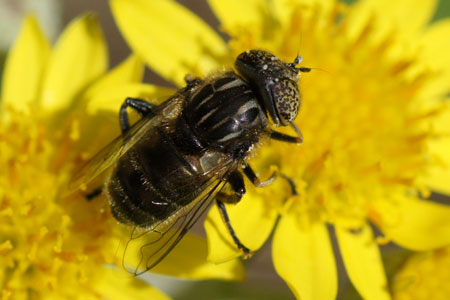 .. ..
 . .
 . .
 Black Lagoon Fly (Eristalinus sepulchralis). Genus: Eristalinus.
Family hoverflies (Syrphidae).
Black Lagoon Fly (Eristalinus sepulchralis). Genus: Eristalinus.
Family hoverflies (Syrphidae).
The yellowish white eyes are covered with
numerous, small, dark spots.
It has stripes on the thorax. In the middle the abdomen is dull.
Furthermore, it is shiny. In the wing lacks the vena spuria. The rear legs are curved.
It is a common hoverfly. It has a preference for moist areas.
In the Netherlands there are two species, but there are many more species outside the Netherlands.
The larva lives in shallow still water with decaying organic matter. It overwinters as a larva.
Length: 9-11 mm. April-September. Palaearctic, Oriental.
 On the cactus Echinocactus grusonii. German: Schwarze
Augenfleck-Schwebfliege.
On the cactus Echinocactus grusonii. German: Schwarze
Augenfleck-Schwebfliege.
|
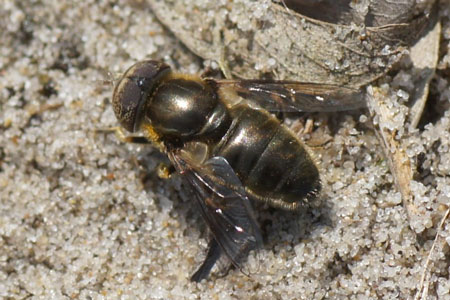 .. ..
 . . . .
 Male.
Male.  Female. Common Lagoon Fly
(Eristalinus aeneus). Genus
Eristalinus. Family hoverflies (Syrphidae). Not
in the garden but in the dunes about 4 km from our house.The yellowish white eyes are covered with
numerous, small, dark spots. The Eristalinus aeneus is completely shiny and lacks the clear long stripes on
the thorax of the Eristalinus sepulchralis.
The wing has a unclear vena spuria.
The rear legs are hardly curved.
Female. Common Lagoon Fly
(Eristalinus aeneus). Genus
Eristalinus. Family hoverflies (Syrphidae). Not
in the garden but in the dunes about 4 km from our house.The yellowish white eyes are covered with
numerous, small, dark spots. The Eristalinus aeneus is completely shiny and lacks the clear long stripes on
the thorax of the Eristalinus sepulchralis.
The wing has a unclear vena spuria.
The rear legs are hardly curved.
In open areas with salty influence like here in the dunes near a small lake.
In the Netherlands they live mainly along the coast.
The larva lives in shallow stagnant or slow flowing water of the bacteria from decaying organic matter.
They haven't problems with the salt in the water. In other countries, the larvae are also found in fresh water.
Length: 10-12 mm. April - October. The adult fly overwinters.
Cosmopolitan (In America introduced). Photos 3-5-2013.
 Eristalinus aeneus male. Eight years after the previous photos for the first time seen in the garden on a wall.
Photo 16-4-2021.
Eristalinus aeneus male. Eight years after the previous photos for the first time seen in the garden on a wall.
Photo 16-4-2021. |
Ferdinandea
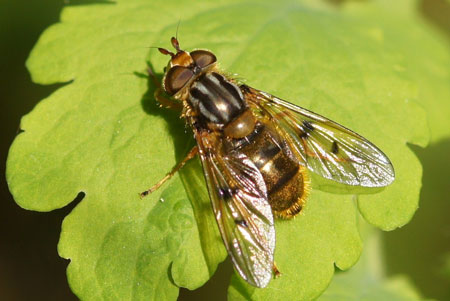 .. ..
 . .
 Eurasian Copperback (Ferdinandea cuprea). Genus: Ferdinandea.
Family hoverflies (Syrphidae).
Eurasian Copperback (Ferdinandea cuprea). Genus: Ferdinandea.
Family hoverflies (Syrphidae).
This hover fly has copper-colored abdomen.
Translated Dutch name: Copper jacket. The wings have two clear dark spots. On the black
thorax grey stripes. On the side of the thorax are stiff hairs.
The larva lives in tree sap and wounds of deciduous trees like birch, oak, willow.
But the larvae can also occur in other situations. Like rotting oak roots, rotting tree hollows and in France even in the roots of artichoke.
The larva overwinters.
Palearctic. Length 7-13 mm
April-September. German: Gemeine
Goldschwebfliege.
|
Myathropa
 .. ..
 . .
 . .
 Common Batman Fly (Myathropa florea). Genus: Myathropa. Family
hoverflies (Syrphidae).
Common Batman Fly (Myathropa florea). Genus: Myathropa. Family
hoverflies (Syrphidae).
It looks like a honey bee. It has a distinctive pattern of grey
bars on the top of the thorax. The Dutch name is skullhoverfly
because of this pattern. Variable
in size: 10-14 mm.
April-October. Palearctic.
They occur in forest edges and shrubs.
The larvae live in damp rotting wood and decaying leaves, water-filled branch axils, manure etc.
German: Totenkopfschwebfliege French: Eristale des fleurs.
|
Didea
Leucozona
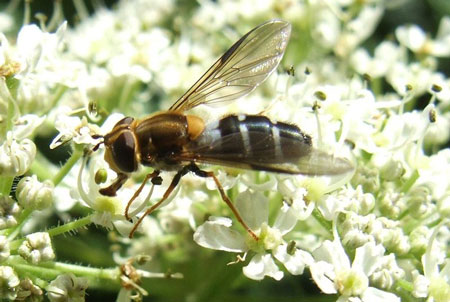 .. ..
 . .
 Pale-saddled Hoary (Leucozona glaucia). Genus: Leucozona. Family hoverflies (Syrphidae). Not in the garden, but in the Lake
District in England! In the Netherlands in South Limburg and some other
places, but it is increasingly rare.
Pale-saddled Hoary (Leucozona glaucia). Genus: Leucozona. Family hoverflies (Syrphidae). Not in the garden, but in the Lake
District in England! In the Netherlands in South Limburg and some other
places, but it is increasingly rare.
Usually you can find the Leucozona glaucia on a white Apiaceae or
Umbelliferae. They always run back and forth. The eggs are also on these plants.
They are especially along forest edges in deciduous forests.
Length 11-3 mm. June-September. Fhe larvae feed on aphids.
|
Bumbel bee mimics
Criorhina
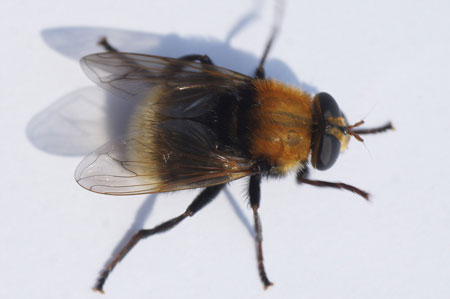 .. ..
 Dimorphic Bumblefly (Criorhina berberina). Genus: Criorhina. Family
hoverflies (Syrphidae).
Dimorphic Bumblefly (Criorhina berberina). Genus: Criorhina. Family
hoverflies (Syrphidae).
It has a broad body with a yellow hairy thorax. There are different color forms. The fly in this picture has a black hairy abdomen with a white tip.
Variation Oxyaccanthae has yellow hairy abdomen.
It is often found in forests and thickets. The larvae live in rotting wood.
It lives on nectar and pollen.
Length: 8-13 mm.
April-August. Europe to eastern Turkey. Photos
26-5-2016. |
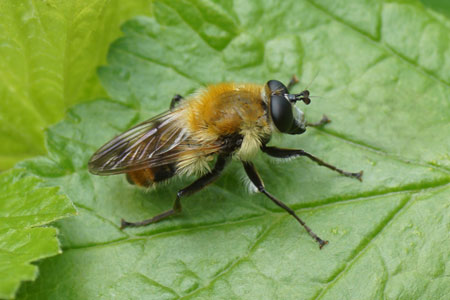 Buff-tailed Bumblefly (Criorhina floccosa). Genus: Criorhina. Family
hoverflies (Syrphidae).
Buff-tailed Bumblefly (Criorhina floccosa). Genus: Criorhina. Family
hoverflies (Syrphidae).
Fairly large hoverfly with an orange hairy thorax and rear part of the abdomen. Front part of the abdomen with pale yellow hair. Quite rare in the Netherlands. Seen in the garden for the first time.
It mainly occurs in deciduous forests. The larvae live in rotting wood of maples.
Length: 12-15 mm. April-June. Europe, to the Caucasus. Photos 10-5-2021. |
Eristalis
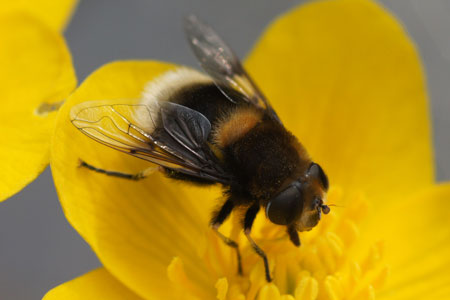 .. ..
 . .
 Female.
Female.  . .
 Male. Furry Drone Fly (Eristalis intricaria). Genus: Eristalis. Family hoverflies (Syrphidae).
Male. Furry Drone Fly (Eristalis intricaria). Genus: Eristalis. Family hoverflies (Syrphidae).
It is an Eristalis, but it looks more like a bumblebee. The legs are black
with white pieces (knee, tar). The shield is lighter. The males are
usually sandy-haired. The females have black on tergite 2 of the abdomen
and white at the tip of the abdomen.
The larva is a rat-tailed maggot.
Length: 11-14 mm.
March-September. Palearctic. German:
Hummel-Keilfleckschwebfliege, Pelzige Mistbiene.
|
Merodon
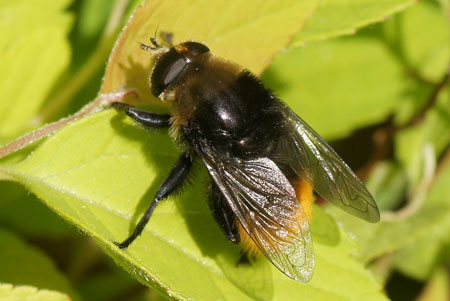 .. ..
 . .
 . .
 . .
 . .
 Narcissus fly, Greater bulb fly (Merodon
equestris). Genus: Merodon. Family hoverflies (Syrphidae).
Narcissus fly, Greater bulb fly (Merodon
equestris). Genus: Merodon. Family hoverflies (Syrphidae).
The hairs have different colour forms. It has
strong, black legs.
Length: 12-14mm. April-July.
Woods, hedgerows, parks and gardens.
Eggs are
laid at the base of foliage of bulbs like bluebell and daffodil. The larvae
follow the foliage down to the bulb and grubs tunnels into the bulb.
Similar species: Volucella bombylans (no
U-shaped bend in the veins) and Eristalis intricaria (legs are
partly pale)
In the Netherlands there are six colour forms. Males and females: bulborum,
equestris, flavicans, transversalis. Only females: nobilis en
validus. German:
Narzissenschwebfliege.
|
Volucella
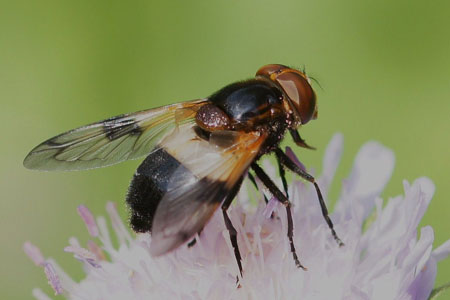 .. ..
 . .
 . .
 Pied Plumehorn, White-banded Drone Fly
(Volucella pellucens). Genus:
Volucella.
Family hoverflies (Syrphidae).
Pied Plumehorn, White-banded Drone Fly
(Volucella pellucens). Genus:
Volucella.
Family hoverflies (Syrphidae).
It has a broad body. It is mainly black, but the front part of the
abdomen has a broad yellow, white band.
It is usually found in woodland, but will enter gardens.
It lives on nectar and pollen
Length: 12-18 mm.
May-September. Europe, Asia, Japan
The female enters the underground paper nests of
the common wasp Vespula vulgaris, or the German wasp, Vespula germanica,
and lays her eggs. The larvae feed on all kind of waste
and even dead wasp grubs and adults.
Fully grown larvae leave the nest and pupate in the soil below.
Family of the Volucella zonaria. Photos
25-6-2010, 10-7-2012. German: Gemeine
Waldschwebfliege. French: Volucelle transparente.
|
Other hoverflies.
Rhingia
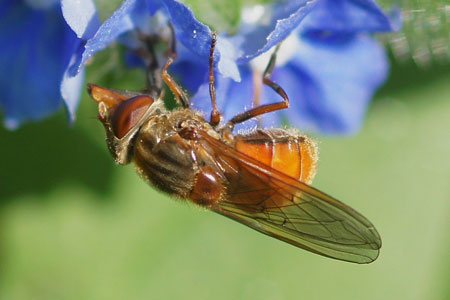 .. ..
 . .
 . .
 Common Snout Fly,
Heineken
Hover Fly
(Rhingia campestris). Genus:
Rhingia.
Family hoverflies (Syrphidae).
Common Snout Fly,
Heineken
Hover Fly
(Rhingia campestris). Genus:
Rhingia.
Family hoverflies (Syrphidae).
It is recognizable by the long straight
snout. The dark thorax is gray dusted, the abdomen is reddish. It looks like the
in the Netherlands rare Rhingia rostrata (in the south). That hoverfly has completely orange legs. Even rarer in the Netherlands is the Rhingia borealis.
The larvae live in dung, especially in cow dung.
Length: 7-11 mm.
April-October.
Photos 25-4-2011, 17-10-2011, 30-8-2012, 4-9-2012.
|
Brachyopa
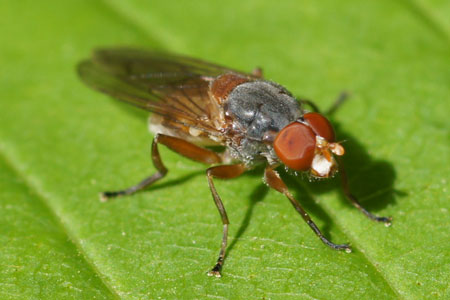 .. ..
 . .
 Pale-shouldered Sapeater (Brachyopa
scutellaris). Genus:
Brachyopa.
Family hoverflies (Syrphidae).
Pale-shouldered Sapeater (Brachyopa
scutellaris). Genus:
Brachyopa.
Family hoverflies (Syrphidae).
These flies are difficult to recognize as a
hoverfly. This is because the dull gray thorax. The abdomen, scutellum and
eyes are striking red orange. It is the only hoverfly of the genus:
Brachyopa
with reddish brown shoulder humps.
Used to be in the Netherlands in the dunes. Now also in other arias of the
Netherlands.
The larvae of this genus live in decaying sap on and in the bark of trees.
The flies are often nearby such places. The Brachyopa
scutellaris also can be found on flowers.
Length: 6-8 mm.
April-June.
Europe.
|
Cheilosia
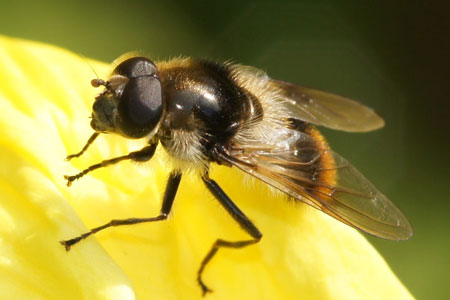 .. ..
 . .
 . .
 Bumblebee Blacklet (Cheilosia illustrata). Genus: Cheilosia.
Family hoverflies (Syrphidae).
Bumblebee Blacklet (Cheilosia illustrata). Genus: Cheilosia.
Family hoverflies (Syrphidae).
A hoverfly of the family
cheilosia with more hairs than most of the members of the family.
A dark spot on the wings. The eyes are hairy. The abdomen is hairy with red hairs on
the end. At the shoulder and under the scutellum are long white hairs.
It is a general fly in the Netherlands now. In 1990, it mainly lives in South
Limburg.
You can find it on Apiaceae or Umbelliferae like hogweed and parsnip.
Length: 9-1 mm.
May-August.
Larvae are found in
the roots of these plants. |
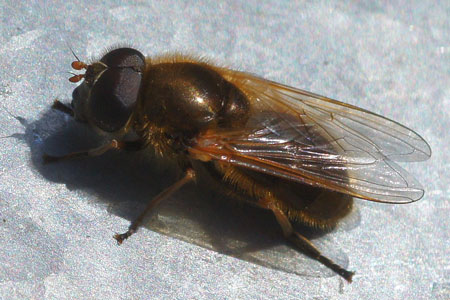 .. ..
 Cheilosia albipila. Genus: Cheilosia. Family
hoverflies (Syrphidae).
Cheilosia albipila. Genus: Cheilosia. Family
hoverflies (Syrphidae).
A hoverfly with short brown red hairs. It therefore looks like a red hairy
mining bee. The base color of the thorax is shiny black. The abdomen is less glossy. The antennae are orange.
The eyes have long hairs (male: dark hairs, female pale hairs). The face is hairless.
Early flowering shrubs such as willow and blackthorn.
The eggs are deposited on different species of thistle. The larva feeds
inside the root or the base of the stem.
Length: 8-12 mm.
March-May. Palearctic. Photo: 6-4-2011.
German: Weiden-Erzschwebfliege.
|
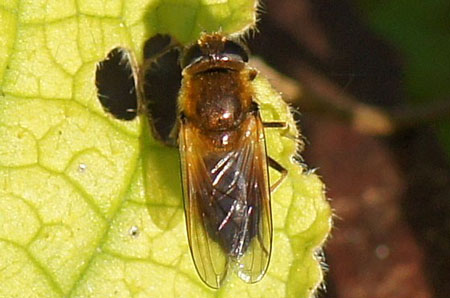 Greater Spring Blacklet (Cheilosia grossa). Genus: Cheilosia. Family
hoverflies (Syrphidae).
Greater Spring Blacklet (Cheilosia grossa). Genus: Cheilosia. Family
hoverflies (Syrphidae).
Not a beautiful picture, because the photo was taken from a distance. Then
it was gone. This is the first and the last
Cheilosia grossa that I've seen in the garden.
A large, shiny Cheilosia with red hair.
The larvae live in various thistle species. They are mainly found inside the rhizome, but sometimes
higher in the stems. The eggs are laid in the rosettes of thistles. The larvae pupate in the ground next to the thistles.
The Cheilosia grossa
life especially near willows. I have no willow in the garden and at present no thistles. Therefore I was so surprised to see the
Cheilosia grossa
here.
Length: 11-12 mm.
March-June. One generation. Palearctic.
Photo 21-03-2012. |
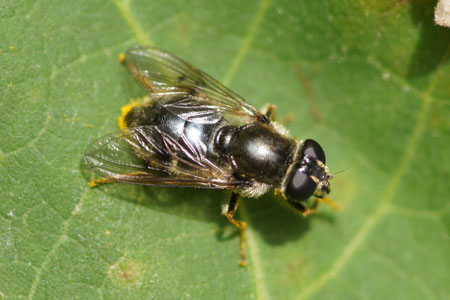 .. ..
 . .
 . .
 Houseleek Blacklet (Cheilosia caerulescens). Genus: Cheilosia.
Family hoverflies (Syrphidae).
Houseleek Blacklet (Cheilosia caerulescens). Genus: Cheilosia.
Family hoverflies (Syrphidae).
A black abdomen with silver hair bands. Wing with darkened cross veins. No hairs on the eyes. Legs partly dark and partly yellow. A prominent face.
It mainly lived in the mountains in Europe. In the Netherlands the first observation
was in 1986 in Limburg. From 1998 there were observations from other parts of the Netherlands.
The food plant of the larva is houseleek. Larvae mine the leaves of
houseleeks. Maybe Cheilosia caerulescens is
spread by the sale of this garden plant. But that is not certain.
The pupae overwinter.
Length 7-11 cm.
May- September. Photos 9-8-2010. |
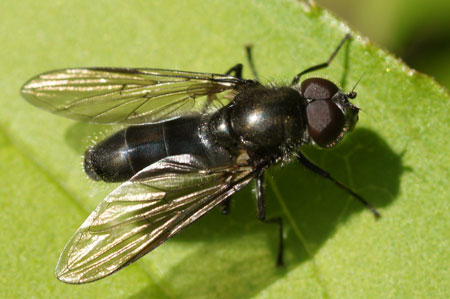 .. ..
 . .
 . .
 . .
 Male.
Male.  Female.
Figwort Blacklet (Cheilosia variabilis). Genus:
Cheilosia. Family hoverflies (Syrphidae). Female.
Figwort Blacklet (Cheilosia variabilis). Genus:
Cheilosia. Family hoverflies (Syrphidae).
A common species on the sandy soils It can be
found at sunny spots along the forest.
A large cheilosia with black legs and antennae.
The larvae live on Scrophularia.
Length: 9-12 mm.
April-August.
Photos 22-4-2008, 18-5-2009, 5-5-2010, 13-4-2012. German: Gemeine
Erzschwebfliege.
|
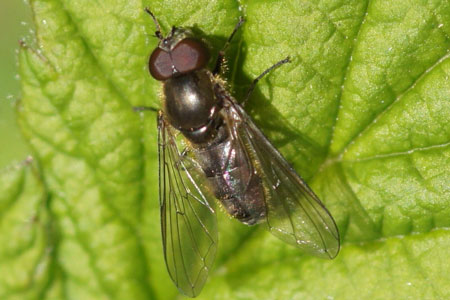 .. ..
 . .
 . .
 Leafmining Blacklet (Cheilosia semifasciata). Genus: Cheilosia.
Family hoverflies (Syrphidae).
Leafmining Blacklet (Cheilosia semifasciata). Genus: Cheilosia.
Family hoverflies (Syrphidae).
First I thought it was an ordinary fly. But at
the way of flying it is to recognize as a hoverfly.
It has some grey spots on the abdomen. De larva is a
leafminer.
The other Cheilosia species aren't leaf-miners. It is a miner on Navelwort (Umbilicus
rupestris) and Orpine (Sedum Telephium)
Length: 8-10 mm.
March-May. |
 .. ..
 . .
 Ragwort Blacklet (Cheilosia bergenstammi). Genus: Cheilosia.
Family hoverflies (Syrphidae).
Ragwort Blacklet (Cheilosia bergenstammi). Genus: Cheilosia.
Family hoverflies (Syrphidae).
The eyes of this Cheilosia are slightly hairy, while the face is not hairy
at all.
This cheilosia is hairy with golden hairs. But that can only be seen on a
highly magnified photo.
The larvae mine the stems and roots of Senico jacobaea.
This hoverfly is found in open
places, where Ragwort grows. Length: 8-10 mm.
April-September. Photos 30-8-2008. |
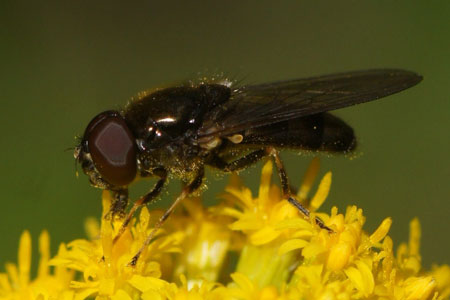 .. ..
 . .
 Male.
Male.  . .
 Female. Bolete Blacklet
(Cheilosia scutellata). Genus:
Cheilosia. Family hoverflies (Syrphidae). Female. Bolete Blacklet
(Cheilosia scutellata). Genus:
Cheilosia. Family hoverflies (Syrphidae).
Yellowish
hairy, hairless eye. Legs partly yellow. Wide center knot. The scutellum
of the female is yellow.
Open forests, mostly sand.
Larvae in mushrooms. In particular boletus.
Length 7-10 mm.
May-September. Photos 27-8-2012, 3-9-2012. |
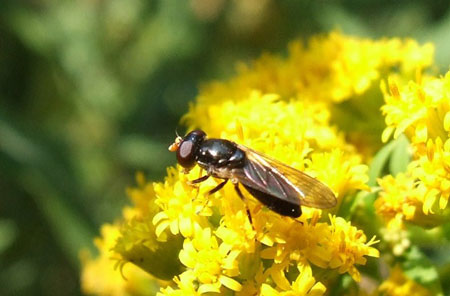 .. ..
 . .
 . .
 . .
 Parsley Blacklet (Cheilosia pagana). Genus: Cheilosia.
Family hoverflies (Syrphidae).
Parsley Blacklet (Cheilosia pagana). Genus: Cheilosia.
Family hoverflies (Syrphidae).
The female is easily recognized because of the large orange third antennal segment.
The male is less easy to recognize. In spring the male is often larger and
lighter in colour than in summer.
The larvae live in cow parsley, angelica and common hogweed. In by fungi
affected rotting roots.
Length: 5- 9 mm.
March- September. Two generations.
Europe and North America. Photos 19-9-2009. |
 .. ..
 . .
 . .
 Female.
Female.  . .
 Male. Yarrow Blacklet
(Cheilosia vernalis).
Genus: Cheilosia. Family hoverflies (Syrphidae).
Male. Yarrow Blacklet
(Cheilosia vernalis).
Genus: Cheilosia. Family hoverflies (Syrphidae).
A small, stocky cheilosia. The eyes are hairy, the face is hairless. Brushes on the edge of the shield. It is variable in terms of
colour of hairs, legs and antennae.
It is found in many different habitats.
The larvae mine in stems of different plants of the family Asteraceae or
Compositae. For example, in Yarrow.
Length: 5-7 mm.
April-September. Two generations. Palearctic. Photos
10-04-2012, 18-9-2012. |
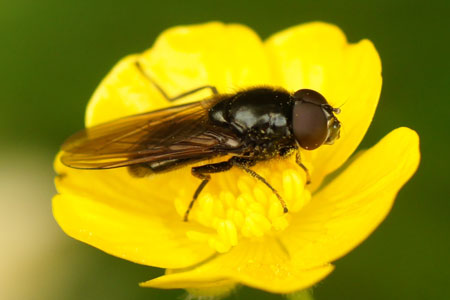 .. ..
 . .
 . .
 Buttercup Blacklet (Cheilosia albitarsis).
Genus: Gitjes (Cheilosia). Family hoverflies (Syrphidae). Not in the garden but in the dunes about 4 km from my house.
Buttercup Blacklet (Cheilosia albitarsis).
Genus: Gitjes (Cheilosia). Family hoverflies (Syrphidae). Not in the garden but in the dunes about 4 km from my house.
Black, hairy eyes (not easy to see), face without hairs. Black legs, but
the middle segments of the tarsus of the front leg are light.
Female with yellow-brown wing roots. It looks like the in the Netherlands
rare Cheilosia ranunculi.
Differences according to Menno Reemer (translated): In C. ranunculi the last tarslid
of the foreleg is widened. And males C. ranunculi additionally have slightly yellowish wing roots, as females C. albitarsis have this too.
A useful field characteristic to recognize the C. ranunculi males between
the C. albitarsis. For final determination you will always have to look at
the tarsi.
Often found near buttercups. The larvae live in the roots of the sharp buttercup and creeping buttercup. (perhaps in other species buttercup)
Length: 7-9 mm.
April-July. One generation. Holarctic.
Photos 6-05-2014.
|
Pipiza
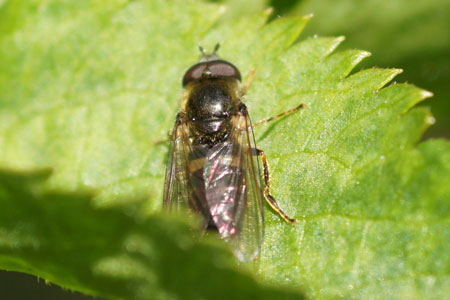 Pale-footed Pithead (Pipiza luteitarsis). Genus: Pipiza. Family
hoverflies (Syrphidae).
Pale-footed Pithead (Pipiza luteitarsis). Genus: Pipiza. Family
hoverflies (Syrphidae).
The whole tarsus of front legs is yellow. Of
the other legs are the last segments of the tarsus yellow. The abdomen is golden yellow hairy.
Han, Gerard, Menno, Jaap thanks for the help with the identification of this fly. This male is not black and therefore difficult to identify. In the Netherlands it is a
rare species!
Length 7-9 mm. April-May. Europe.
Photo 17-4-2011. |
Heringia
 .. ..
 .
Heringia spec. Genus: Heringia.
(Synonym Neocnemodon). Family hoverflies (Syrphidae). .
Heringia spec. Genus: Heringia.
(Synonym Neocnemodon). Family hoverflies (Syrphidae).
Heringia is a family, consisting of small black
hoverflies. Females of this family are hard to identify. But the males are
also not easy to identify from a photo.
In the Netherlands there are seven species.
Like Pipzella it has a flat face. The third antennal segment is less long.
You see the most species oft on the leaves.
Length: 5-8 mm.
The larvae feed on aphids.
Photos females 3-7-2011. Photo male
29-7-2009. |
Pipizella
 .. ..
 . .
 Male. Pipizella spec.
Family hoverflies (Syrphidae).
Male. Pipizella spec.
Family hoverflies (Syrphidae).
Usually it is not possible to indentify pipizella species from a photo.
Probably Pipizella viduata. That is the most common of the six species in the Netherlands.
They are small black hoverflies with a flat face. The third antennal segment is quite long. The legs are black with yellow.
It is found on umbelliferous. Here on celery.
Larvae are found near root lice include on fireweed.
Length 5-7 mm.
The Palearctic.
Photo 11-7-2010, 14-5-2013.
|
Melanogaster, Chrysogaster
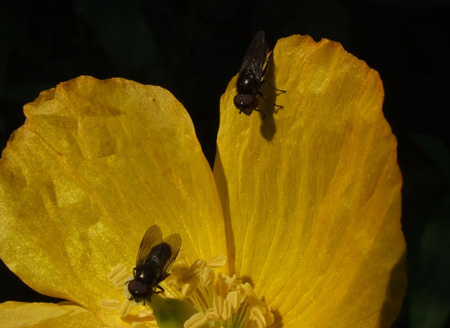 .. ..
 . .
 M
M Female. Common Wrinklehead
(Melanogaster hirtella). Genus:
Melanogaster. Family hoverflies (Syrphidae).
Female. Common Wrinklehead
(Melanogaster hirtella). Genus:
Melanogaster. Family hoverflies (Syrphidae).
As you see a very small black hoverfly.
On this photo on the flower of a Welsh
poppy (Meconopsis
cambrica).
The Melanogaster hirtella is (just like the
Cheilosia albitarsis) a real buttercup species. The Melanogaster at the other photos
is sitting on a marsh marigold.
Often in meadows near water. The eggs are attached under leaves of plants near the water. The larvae live along the waterfront. They overwinter as larvae.
Length: 6-8 mm.
April-July. Photos 14-5-2008, 24-5-2011, 14-5-2013. |
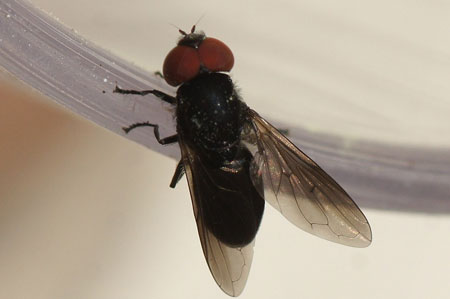 .. ..
 . .
 Dark-winged Wrinklehead (Chrysogaster solstitialis).
Genus: Chrysogaster. Family hoverflies (Syrphidae).
Dark-winged Wrinklehead (Chrysogaster solstitialis).
Genus: Chrysogaster. Family hoverflies (Syrphidae).
A dark hoverfly. The body is black and the wings are completely darkened. Thorax male is dull black, the
thorax of the female has a purple sheen. Strikingly large red eyes.
Chrysogaster solstitialis you often find on umbelliferous. The fly on the picture I found in the
scullery. The first time that I saw this species in our garden. Since 1990
it has expanded to the west and north of the Netherlands, where we live.
The larvae live in water with rotting wood.
Length 6-8 mm.
April-September. Two generations. Photos 23-6-2013.
German:
Gemeine Smaragdschwebfliege.
|
Paragus.
Eumerus
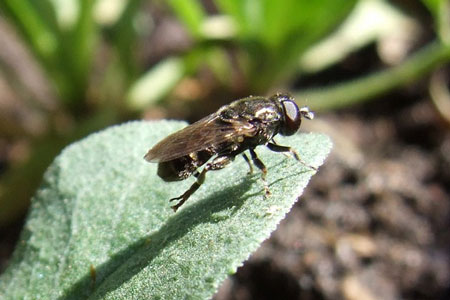 .. ..
 . .
 . .
 Onion
bulb fly, Lesser Bulb Fly (Eumerus funeralis = Eumerus
tuberculatus).
Genus: Eumerus. Family hoverflies (Syrphidae).
Onion
bulb fly, Lesser Bulb Fly (Eumerus funeralis = Eumerus
tuberculatus).
Genus: Eumerus. Family hoverflies (Syrphidae).
A small, black hoverfly. It has a "lump" by an extension at the
beginning of the thigh. See detail photo.
Length: 5-6 mm.
April-September.
The
larvae feed on bulbs of onions, iris, narcissus or hyacinths.
Palearctic. But introduced in North - and South America and Australia.
Photos 9-6-2008. |
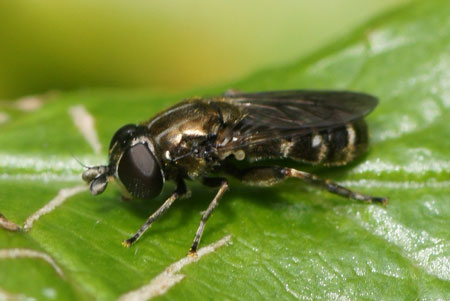 .. ..
 . .
 . .
 Eumerus spec.
Genus: Eumerus. Family hoverflies (Syrphidae).
Eumerus spec.
Genus: Eumerus. Family hoverflies (Syrphidae).
Some pictures of globes gliding, a name isn't
possible. Besides the Eumerus funeralis is the Eumerus strigatus a general hoverfly in the Netherlands. The other species are rare.
Photos 10-5-2009, 19-7-2012, 29-8-2012. |
To hoverflies
2
I want to thank everyone, who has helped me (waarneming.nl)
to identify. In particular
Gerard Pennards, Han Endt and Menno Reemer.
Nederlands /
Dutch
 
Subpage flies:
Tachinidae
Blow-flies
(Calliphoridae) House
flies (Muscidae) Soldierflies
(Stratiomyidae) Root-Maggot
Flies (Anthomyiidae) Small
flies Gnats
Subpage wasps, bees, bumblebees: Parasitica, Ichneumonidae
Sawflies
symphyta Bumblebees
Bee hotel
Subpage France: Insects
France
|
